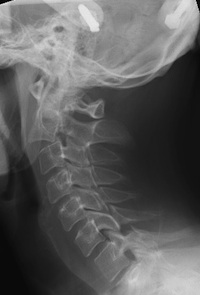
C Spine Plain Film Cases
last authored:
last reviewed:
Introduction
The following cases have been written to facilitate practice of reading C-spine films, and to identify C-spine injuries.
For more information, please read:
Case One
introduction
Mr. H is a 35 year old male who presents to the emergency department after being involved in a motor vehicle collision (MVC).
What would you like to know about the patient history?
This patient was driving on the highway (ie >100km/h) when his car slipped on ice and collided with the median. He is complaining of neck pain which happened immediately after the collision. He was wearing a seat belt, but his car does not have airbags.
What would you like to know on physical exam?
His vital signs are stable. He is alert and oriented. ABC’s are ok.
Upon palpation of the neck, midline tenderness is noted. The patient denies paresthesia in his arms or legs.
Does this patient need a C-spine X-ray?
 Yes; His mechanism of injury (MVC at >100km/h) is considered “high-risk”, pain onset was immediate, and the patient has midline neck pain on exam.
Yes; His mechanism of injury (MVC at >100km/h) is considered “high-risk”, pain onset was immediate, and the patient has midline neck pain on exam.
You get the following lateral view of the C-spine.
image courtesy of wikipedia
Is this image adequate?
Yes; C1-C7 are clearly visualized. Bone and soft tissue can be distinguished.
Is the alignment correct?
No, there is a step in the anterior line between C2 and C3.
Are the bones intact? Is the cartilage ok? Is there any soft tissue swelling?
Yes, the cortex of each vertebrae and spinous process is intact.
Yes.
This is hard to tell because the body of C2 is pushing the soft tissues anteriorly.
What is the diagnosis?
This patient has a Hangman’s fracture. His neck was hyperextended and compressed to produce this injury. His head may have hit his windshield during his collision.
Case Two
introduction
Mr. H is a 35 year old male who presents to the emergency department after being involved in a motor vehicle collision (MVC).
What would you like to know about the patient history?
This patient was driving on the highway (ie >100km/h) when his car slipped on ice and collided with the median. He is complaining of neck pain which happened immediately after the collision. He was wearing a seat belt, but his car does not have airbags.
What would you like to know on physical exam?
His vital signs are stable. He is alert and oriented. ABC’s are ok.
Upon palpation of the neck, midline tenderness is noted. The patient denies paresthesia in his arms or legs.
Does this patient need a C-spine X-ray?
 Yes; His mechanism of injury (MVC at >100km/h) is considered “high-risk”, pain onset was immediate, and the patient has midline neck pain on exam.
Yes; His mechanism of injury (MVC at >100km/h) is considered “high-risk”, pain onset was immediate, and the patient has midline neck pain on exam.
You get the following lateral view of the C-spine.
image courtesy of wikipedia
Is this image adequate?
Yes; C1-C7 are clearly visualized. Bone and soft tissue can be distinguished.
Is the alignment correct?
No, there is a step in the anterior line between C2 and C3.
Are the bones intact? Is the cartilage ok? Is there any soft tissue swelling?
Yes, the cortex of each vertebrae and spinous process is intact.
Yes.
This is hard to tell because the body of C2 is pushing the soft tissues anteriorly.
What is the diagnosis?
This patient has a Hangman’s fracture. His neck was hyperextended and compressed to produce this injury. His head may have hit his windshield during his collision.
